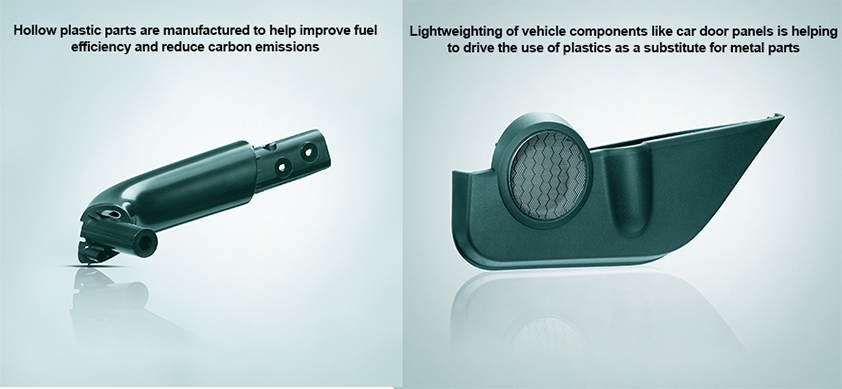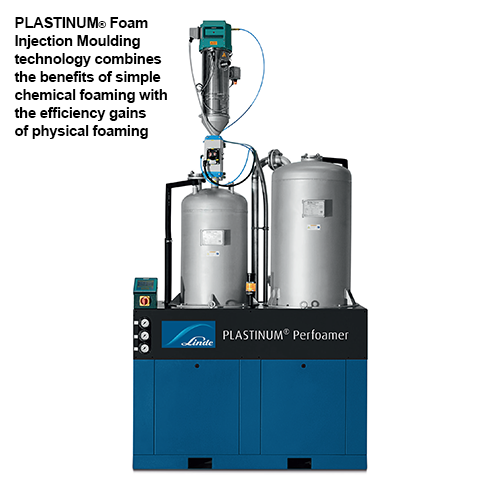
The best of both worlds
The global impact of Covid-19 has been unprecedented, exposing industries worldwide to multiple challenges. Lockdowns to curb the transmission of the virus, market uncertainty, decreased investment and operational constraints have led to the postponement of projects worldwide and unavoidable consequences on the global economy.
With many manufacturing activities globally being slowed down or even halted, demand for plastic products was impacted significantly, with the global market exhibiting a decline of 1.2 percent in 2020 and Europe suffering a downwards slide of 5.1 percent at 55 million tons. Demand for plastics from the automotive, building and construction industries, in particular, declined substantially. The automobile sector, one of the biggest buyers of plastics after the packaging and construction industries, saw its consumption plunge by 18 percent (or 900,000 tons) in Europe.
The opportunity
Despite recent challenges, the plastics industry is seeing recovery, with an annual growth rate (CAGR) of 3.4 percent forecasted between 2021 to 2028. Resurgence in plastic consumption in those hit hardest – construction and automotive – is expected to support that growth. The push towards lightweighting to improve fuel efficiency and reduce carbon emissions will drive the use of plastics as a substitute for metals in the manufacturing of automotive components.
Regulations around natural resource depletion, recyclability of conventional materials, such as metal and wood, and legislation to improve energy efficiency are also expected to drive greater demand for plastic from the construction industries for a wide range of applications such as insulation, pipes, cables, flooring, windows and storage tanks. Plastics have 85 percent less gravity compared to metals and when used in the automotive and construction industries, they enable approximately 80 percent weight savings and 30 percent to 50 percent cost savings in individual components.
In short, there has never been a more important time for the industry to optimize productivity, lower its energy consumption and reduce costs.
Only 80 percent to 90 percent of injection moulding machine capacity time actually consists of productive operation. Valuable manufacturing time is lost due to scheduled downtime and technical failures as well as the set-up process. While machine maintenance and mould changes can help reduce downtime, it is through cycle time optimization where the greatest benefit can be derived.
Cycle time plays a significant role in the injection moulding process, including the quality of the parts produced, but especially the impact it makes on a company’s financial bottom line. Eliminating seconds from a cycle time can lead to an increased number of parts produced in the same or less time.
Advanced technologies for improved productivity
Industrial gases play an indispensable role in a number of process steps in plastics manufacturing – two of which are as blowing agents for foam injection moulding (FIM) and as a pressure medium for gas injection moulding (GIM).
Up until now, manufacturers who relied on foam injection processes have had to choose between physical and chemical foaming techniques. With chemical processes, a foaming agent is mixed with the plastic granulate. Easy to handle, this process can be installed on standard injection moulding machines. However, unlike physical foaming processes, chemical techniques only enable low foaming pressures, making them ill-suited to plastics with thin walls. Chemical blowing agents are also costly and unwanted by-products are created leaving residues on the mould. With physical blowing techniques, the blowing agent is typically injected directly into the melted polymer. This requires additional modifications to the injection moulding machine and a special screw to ensure homogeneous mixing with the polymer melt. A high-pressure gas dosing unit for controlled gas injection is also required. This pushes up installation costs and limits flexibility.
 Linde teamed up with Kunststoff-Institut Lüdenscheid (KIMW) and ProTec Polymer Processing GmbH to develop a new process combining the best of both worlds. PLASTINUM® Foam Injection Moulding technology combines the benefits of simple chemical foaming with the efficiency gains of physical foaming. This technology enables foaming on standard injection moulding machines. The plastic granulate is impregnated with the blowing agent carbon dioxide (CO2) under pressure before being fed into the injection moulding machine, with the gas diffusing into the granulate. CO2 is dissolved in the melt during plastification and forms microcellular gas bubbles when the pressure is relieved as the melt is injected into the cavity. In this way, considerable material and weight savings can be achieved.
Linde teamed up with Kunststoff-Institut Lüdenscheid (KIMW) and ProTec Polymer Processing GmbH to develop a new process combining the best of both worlds. PLASTINUM® Foam Injection Moulding technology combines the benefits of simple chemical foaming with the efficiency gains of physical foaming. This technology enables foaming on standard injection moulding machines. The plastic granulate is impregnated with the blowing agent carbon dioxide (CO2) under pressure before being fed into the injection moulding machine, with the gas diffusing into the granulate. CO2 is dissolved in the melt during plastification and forms microcellular gas bubbles when the pressure is relieved as the melt is injected into the cavity. In this way, considerable material and weight savings can be achieved.
In addition, the process enhances product quality by ensuring high dimensional stability and functionality of the foamed injection moulded parts. The PLASTINUM® Perfoamer from system partner ProTec Polymer Processing GmbH is the central element of the technology. It can be easily moved from one injection moulding machine to another or can even supply multiple machines at the same time, making the production process more flexible.
When it comes to manufacturing methods using gas injection technology, traditionally, this has relied on high-pressure nitrogen (N2) gas to shape a hollow or channel in a moulded plastic part. However, Linde is again leveraging the properties of CO2 across its PLASTINUM® GIM C portfolio. By replacing gaseous N2 with liquid CO2 the process matches the heat removal capacity and cycle times of water injection moulding, but does not leave moisture on the products or mould, so eliminating the drying step associated with the fluid injection cycle. In addition, CO2 has a higher density and specific thermal capacity than nitrogen and provides significant cooling during expansion, which means it accelerates cycle times by as much as 50 percent.
For both PLASTINUM® FIM and GIM technologies, Linde is leveraging the unique characteristics of CO2. Often coming under scrutiny, when captured as a by-product from another chemical process – such as ammonia synthesis or ethylene oxide production – and used as a natural alternative to more harmful gases, CO2 can play its part in resource efficiency. Committed to mitigating the effects of climate change, Linde seeks to minimize its carbon footprint by recycling CO2 instead of generating new streams of this gas and around 80 percent of its supplies are captured from other chemical processes.
Carbon dioxide in action at Wirth Werkzeugbau GmbH
Wirth Werkzeugbau GmbH is a leader in the design and manufacture of larger plastic tools and moulds weighing up to 40 tons. The company operates its own technical center where it develops and tests its own manufacturing process technology. For the past decade, a major focus has been on designing solutions for physical foaming, which today accounts for over 50 percent of the tools manufactured at Wirth.
Up to now, the N2-based process had proven itself, but was found to be expensive and less economical for smaller and medium-sized injection moulding machines. Managing Director, Werner Wirth, set out to find a powerful alternative that could be: “More cost-efficient, less complex and – above all – more flexible, because we wanted to offer our customers a future-proof solution for every machine on the horizon.”
Wirth and his team found what they were looking for in Linde’s CO2-based PLASTINUM® FIM technology. With several customers now performing trials at the company’s Wirth Tech Centre, they are able to offer injection moulders a proven and easy-to-implement solution which doesn’t require modifications to existing production lines – and at considerably lower investment cost.
At AQ Anton
With an annual revenue in excess of 22 million euros in only 20 years, Hungary-based AQ Anton has quickly grown into successful company specializing in tooling, machining and plastics. A pioneer in the adoption of cutting-edge technologies such as multicomponent injection moulding, hot stamping, tampon printing, ultrasonic welding and conditioning, GIM was a natural fit for the company’s wide technology portfolio.
Bosch, a key customer, contacted AQ Anton about a new GIM line to produce handles for its global brand of chainsaws, prompting the firm to expand its installed base of 21 GIM machines. Exploring all injection moulding options in search of a solution with the ability to increase its competitive position by accelerating cycle times, AQ Anton turned to its trusted gas supplier, Linde.
Working closely with its long-standing partner Maximator, a leading provider of high-pressure gas equipment, Linde was confident that its innovative, patented CO2-based PLASTINUM® GIM solution was best positioned to meet the customer’s demanding cycle time – which Linde expected to reduce by up to 55 percent – as well as cost and other process efficiency targets.
Tests run by AQ Anton benchmarking N2 against CO2 demonstrated the advantages of the new approach, with the company subsequently rolling out Linde’s CO2-based PLASTINUM® GIM on a manifold cylinder pallet (MCP) for reliable gas supplies. “We are constantly exploring new technology-driven business opportunities and Linde’s PLASTINUM® GIM with CO2 quickly emerged as the perfect fit for our culture of innovation, giving us a valuable competitive lead in this space,” says Krisztina Balogh, Materials Manager at AQ Anton.
As the only company to offer this technology, Linde’s broad reference customer base indicates that early adopters of GIM technology with CO2 are already benefiting from significant gains in process stability and part quality.
Paolo Kirchpfening / Andreas Praller
Paolo Kirchpfening is Global Commercialization Linde Technologies, Plastics and Andreas Praller is Global Technology Expert, Plastics, at Linde. Linde is a leading global industrial gases and engineering company serving a variety of markets including chemicals & energy, food & beverage, electronics, healthcare, manufacturing, metals and mining. Linde’s industrial gases are used in countless applications, from life-saving oxygen for hospitals to hydrogen for clean fuels. Linde also delivers state-of-the-art gas processing solutions to support efficiency improvements and emissions reductions.
www.linde.com